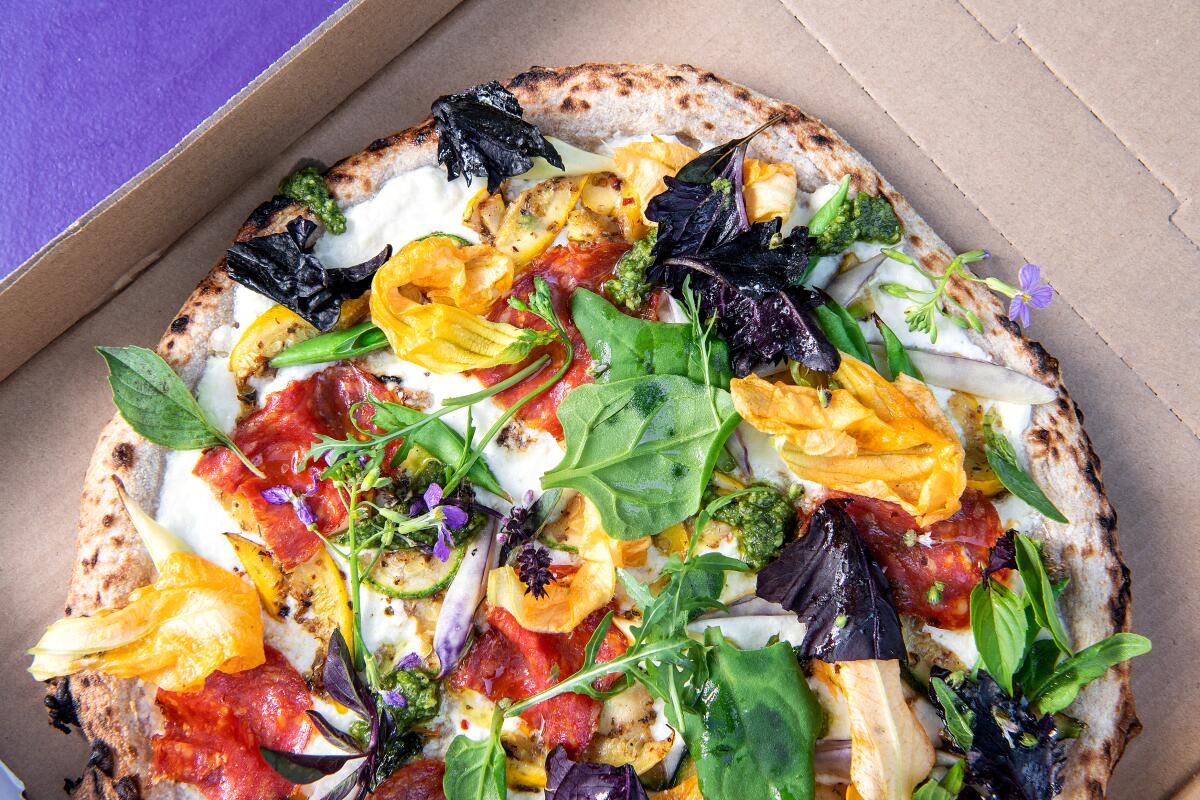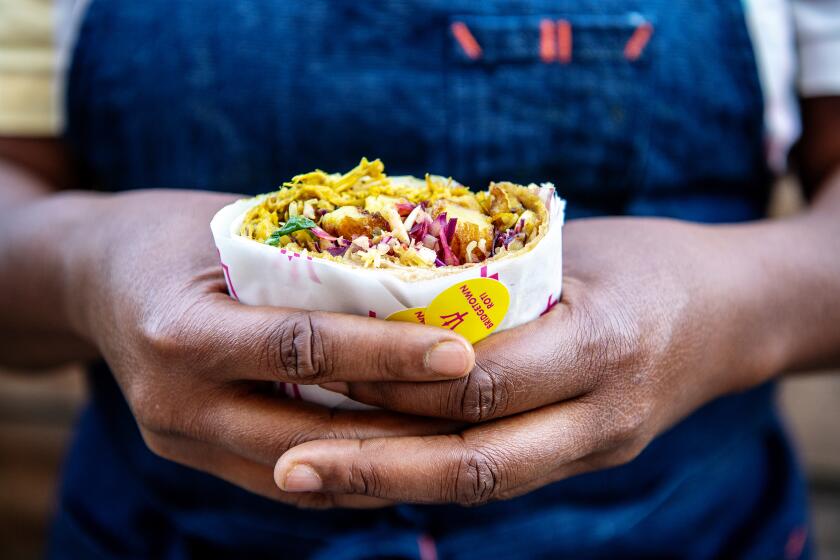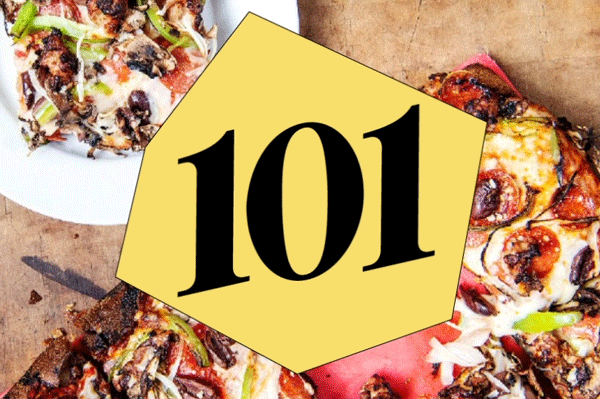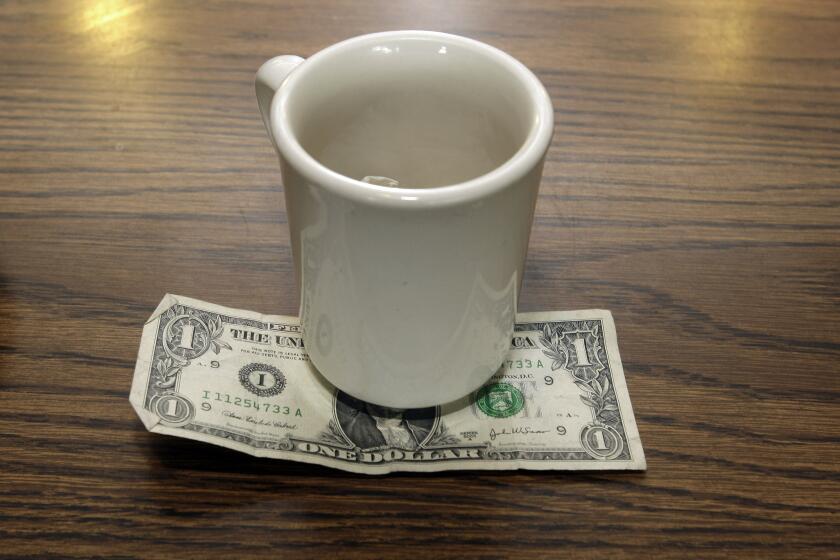L.A.’s pop-up restaurants demonstrate the urgency and creativity of our times

- Share via
In mid-May, Nguyen Bui, a former sous chef at Rustic Canyon in Santa Monica, posted an announcement on his Instagram account: He was starting a takeout project called Ăn Cơm. The name translates literally as “eat rice,” though its informal meaning stems from a Vietnamese greeting: Ăn cơm chưa? Have you eaten yet?
“The dishes I’ll be offering will be based on staples that my family have always looked to for comfort, especially during times like these,” Bui wrote in the post. “I look forward to bringing that spirit to your homes.”
Thịt kho (pork belly in fish sauce caramel with quail eggs and pickled mustard greens), curried chicken fragrant with lemongrass, ca tim nuong (marinated eggplant finished with scalding scallion oil), a latticed wedge of pastelito layered with banana jam and cream cheese, and a chocolate chip cookie crowned with dried persimmon made the cut for Bui’s first menu. He would later add caramel-braised catfish and five-spice roasted chicken bronzed in soy glaze.
Bui’s first round of orders sold out in a day. Soon his weekly roster of dishes was snapped up within hours of being posted. The food nourished body and soul for his customers, as he had hoped; I was lucky a friend shared some of his haul with me.
Bui posted a final round of dishes on Aug. 15 — and then, as suddenly as it had arrived, he discontinued the endeavor. “An Com was an experiment that wasn’t sustainable,” Bui said on the phone recently. “Maybe when I can find the right space for cooking these kinds of dishes, I’ll circle back to it.” Those of us sustained by his cooking can only wait.
Bui’s arc captures one ephemeral snapshot of unprecedented times. A kinetic, evolving takeout subculture has become a tangible part of pandemic-era Los Angeles. Led by furloughed, laid-off and otherwise unemployed chefs and dining room managers, these self-starters are cooking compelling, often deeply personal food — in commissary incubators, rented restaurant kitchen spaces or out of their own homes. They post menu options on social media feeds, take orders via DM and accept payment through mobile services. Some require curbside pickup; others deliver.
Often these takeout projects are labeled as “Instagram pop-ups.” The tag doesn’t do justice to the movement, though it does convey their (presumably) temporary character and places them in a context the city understands: Los Angeles has the country’s richest history of culinary transience.
The best pop-ups take on 2020 and reshape the future of L.A. dining.
Mexican and Chinese street food vendors have been staples of our urban life since the late 1800s. Taco stands are as intrinsic as traffic and sunshine. Out of the Great Recession came the food-truck cults and our modern, tremendously broad definitions around pop-ups: restaurant kitchen takeovers, tasting menus in surprise locations (a parking structure, an airport hangar, a hidden garden), star chef collaborations, smash burger residencies, a khachapuri side hustle in a Hollywood sandwich shop … anything fleeting, anything mutable.
Today’s takeout projects, born of urgency, join the lineage. The chefs behind them embody the pluralism of Los Angeles: The year has brought Balinese long bean salad and sambar, glimmering chirashi don, oxtail plates crisscrossing Jamaican and East African favors, Chicano barbecue, Burmese curry and paratha and a world of cakes and pies. Their efforts are a response to the crisis. They are sources of revenue. They are means of survival, literally and creatively.
The consistent business that many pop-ups have enjoyed capitalizes on the irresistibility of transience. Even in a pandemic, food obsessives want the secret, cachet-laden thing that’s a score to snag.
It’s tempting to over-romanticize their presence. The autonomy of crafting one’s own dishes outside of traditional kitchen hierarchy can be freeing. Phert Em, the previous manager of downtown’s Bar Amá who evolved her tasting menu pop-up, Khemla, into a pandemic-era delivery service, put it this way: “Starting something like this right now is a way to reinvent yourself, to express how you want to live your life and to answer the question, ‘What’s the next step?’”
But wearing every hat in a tiny, provisional food business is grueling. It’s why many pop-ups end abruptly, like a TV show in need of a series finale. I’ve noticed chefs often flatly spell it out on social media: “I’m exhausted. I’m taking a break. See you in a couple of weeks.”
Even in its mercurial nature, the talent coming forth is seeding the next generation of Los Angeles dining. It’s why we’ve featured Em and 10 other exceptional pop-up projects in addition to the year’s 101 paragons. Their runs could conclude at any time, without warning or farewell, but that’s the liminal space we’re in. When talking to the chefs and operators about their pandemic-era takeout projects, I’ve asked them what they think the future holds for their enterprise. “I don’t know,” in some variation, is the consistent answer. Is there any other honest response?
More to Read
Eat your way across L.A.
Get our weekly Tasting Notes newsletter for reviews, news and more.
You may occasionally receive promotional content from the Los Angeles Times.












